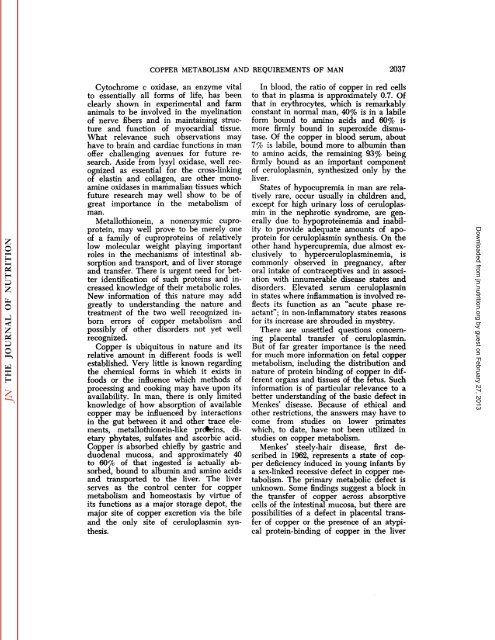conspectus of researchon copper metabolism and requirements
conspectus of researchon copper metabolism and requirements
conspectus of researchon copper metabolism and requirements
Create successful ePaper yourself
Turn your PDF publications into a flip-book with our unique Google optimized e-Paper software.
COPPER METABOLISM AND REQUIREMENTS OF MAN 2037<br />
Cytochrome c oxidase, an enzyme vital<br />
to essentially all forms <strong>of</strong> life, has been<br />
clearly shown in experimental <strong>and</strong> farm<br />
animals to be involved in the myelination<br />
<strong>of</strong> nerve fibers <strong>and</strong> in maintaining struc<br />
ture <strong>and</strong> function <strong>of</strong> myocardial tissue.<br />
What relevance such observations may<br />
have to brain <strong>and</strong> cardiac functions in man<br />
<strong>of</strong>fer challenging avenues for future re<br />
search. Aside from lysyl oxidase, well rec<br />
ognized as essential for the cross-linking<br />
<strong>of</strong> elastin <strong>and</strong> collagen, are other monoamine<br />
oxidases in mammalian tissues which<br />
future research may well show to be <strong>of</strong><br />
great importance in the <strong>metabolism</strong> <strong>of</strong><br />
man.<br />
Metallothionein, a nonenzymic cuproprotein,<br />
may well prove to be merely one<br />
<strong>of</strong> a family <strong>of</strong> cuproproteins <strong>of</strong> relatively<br />
low molecular weight playing important<br />
roles in the mechanisms <strong>of</strong> intestinal ab<br />
sorption <strong>and</strong> transport, <strong>and</strong> <strong>of</strong> liver storage<br />
<strong>and</strong> transfer. There is urgent need for bet<br />
ter identification <strong>of</strong> such proteins <strong>and</strong> in<br />
creased knowledge <strong>of</strong> their metabolic roles.<br />
New information <strong>of</strong> this nature may add<br />
greatly to underst<strong>and</strong>ing the nature <strong>and</strong><br />
treatment <strong>of</strong> the two well recognized in<br />
born errors <strong>of</strong> <strong>copper</strong> <strong>metabolism</strong> <strong>and</strong><br />
possibly <strong>of</strong> other disorders not yet well<br />
recognized.<br />
Copper is ubiquitous in nature <strong>and</strong> its<br />
relative amount in different foods is well<br />
established. Very little is known regarding<br />
the chemical forms in which it exists in<br />
foods or the influence which methods <strong>of</strong><br />
processing <strong>and</strong> cooking may have upon its<br />
availability. In man, there is only limited<br />
knowledge <strong>of</strong> how absorption <strong>of</strong> available<br />
<strong>copper</strong> may be influenced by interactions<br />
in the gut between it <strong>and</strong> other trace ele<br />
ments, metallothionein-like proteins, di<br />
etary phytates, sulfates <strong>and</strong> ascorbic acid.<br />
Copper is absorbed chiefly by gastric <strong>and</strong><br />
duodenal mucosa, <strong>and</strong> approximately 40<br />
to 60r/c <strong>of</strong> that ingested is actually ab<br />
sorbed, bound to albumin <strong>and</strong> amino acids<br />
<strong>and</strong> transported to the liver. The liver<br />
serves as the control center for <strong>copper</strong><br />
<strong>metabolism</strong> <strong>and</strong> homeostasis by virtue <strong>of</strong><br />
its functions as a major storage depot, the<br />
major site <strong>of</strong> <strong>copper</strong> excretion via the bile<br />
<strong>and</strong> the only site <strong>of</strong> ceruloplasmin syn<br />
thesis.<br />
In blood, the ratio <strong>of</strong> <strong>copper</strong> in red cells<br />
to that in plasma is approximately 0.7. Of<br />
that in erythrocytes, which is remarkably<br />
constant in normal man, 40% is in a labile<br />
form bound to amino acids <strong>and</strong> 60% is<br />
more firmly bound in Superoxide dismutase.<br />
Of the <strong>copper</strong> in blood serum, about<br />
1% is labile, bound more to albumin than<br />
to amino acids, the remaining 93% being<br />
firmly bound as an important component<br />
<strong>of</strong> ceruloplasmin, synthesized only by the<br />
liver.<br />
States <strong>of</strong> hypocupremia in man are rela<br />
tively rare, occur usually in children <strong>and</strong>,<br />
except for high urinary loss <strong>of</strong> ceruloplas<br />
min in the nephrotic syndrome, are gen<br />
erally due to hypoproteinemia <strong>and</strong> inabil<br />
ity to provide adequate amounts <strong>of</strong> apoprotein<br />
for ceruloplasmin synthesis. On the<br />
other h<strong>and</strong> hypercupremia, due almost ex<br />
clusively to hyperceruloplasminemia, is<br />
commonly observed in pregnancy, after<br />
oral intake <strong>of</strong> contraceptives <strong>and</strong> in associ<br />
ation with innumerable disease states <strong>and</strong><br />
disorders. Elevated serum ceruloplasmin<br />
in states where inflammation is involved re<br />
flects its function as an "acute phase reactant";<br />
in non-inflammatory states reasons<br />
for its increase are shrouded in mystery.<br />
There are unsettled questions concern<br />
ing placental transfer <strong>of</strong> ceruloplasmin.<br />
But <strong>of</strong> far greater importance is the need<br />
for much more information on fetal <strong>copper</strong><br />
<strong>metabolism</strong>, including the distribution <strong>and</strong><br />
nature <strong>of</strong> protein binding <strong>of</strong> <strong>copper</strong> in dif<br />
ferent organs <strong>and</strong> tissues <strong>of</strong> the fetus. Such<br />
information is <strong>of</strong> particular relevance to a<br />
better underst<strong>and</strong>ing <strong>of</strong> the basic defect in<br />
Menkes' disease. Because <strong>of</strong> ethical <strong>and</strong><br />
other restrictions, the answers may have to<br />
come from studies on lower primates<br />
which, to date, have not been utilized in<br />
studies on <strong>copper</strong> <strong>metabolism</strong>.<br />
Menkes' steely-hair disease, first de<br />
scribed in 1962, represents a state <strong>of</strong> cop<br />
per deficiency induced in young infants by<br />
a sex-linked recessive defect in <strong>copper</strong> me<br />
tabolism. The primary metabolic defect is<br />
unknown. Some findings suggest a block in<br />
the transfer <strong>of</strong> <strong>copper</strong> across absorptive<br />
cells <strong>of</strong> the intestinal mucosa, but there are<br />
possibilities <strong>of</strong> a defect in placental trans<br />
fer <strong>of</strong> <strong>copper</strong> or the presence <strong>of</strong> an atypi<br />
cal protein-binding <strong>of</strong> <strong>copper</strong> in the liver<br />
Downloaded from<br />
jn.nutrition.org<br />
by guest on February 27, 2013
















